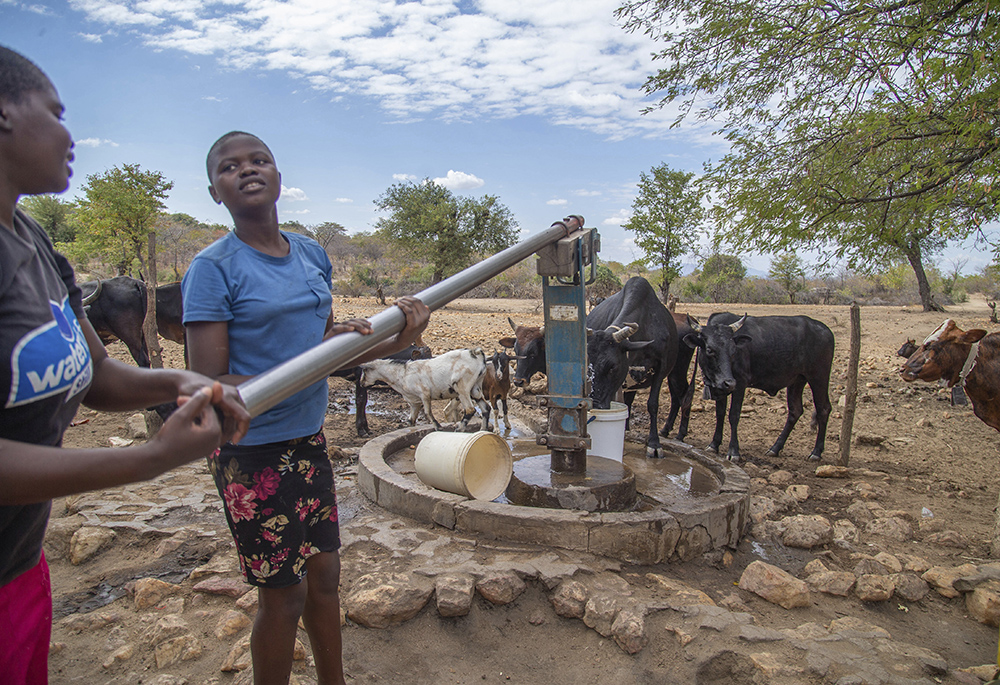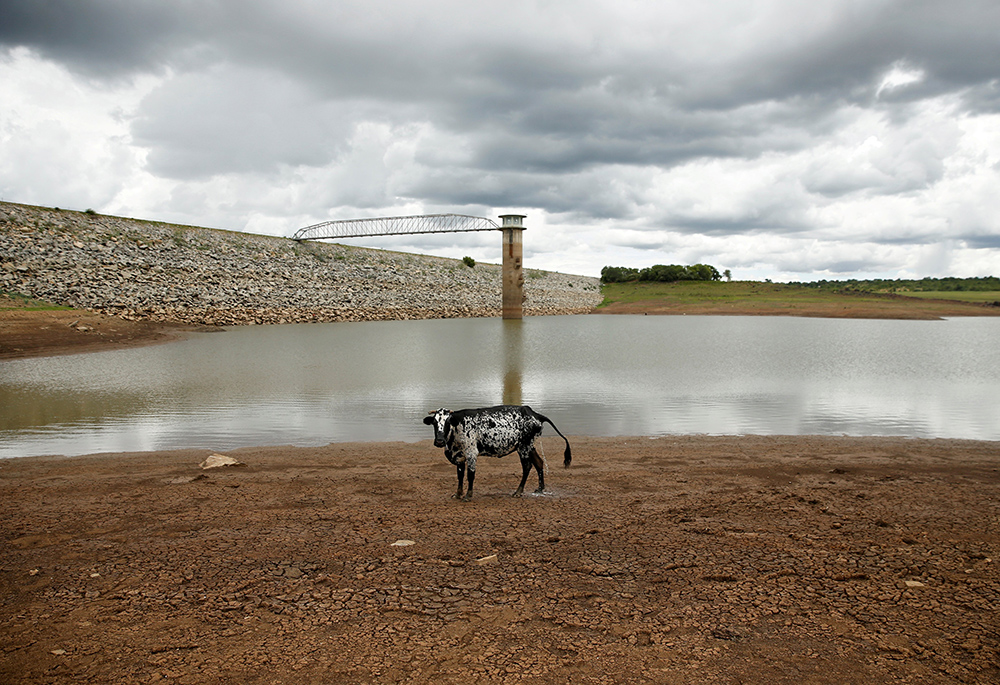
Villagers pump water at a borehole July 2 in Mudzi, Zimbabwe. The United Nations' food agency said Oct. 15 that months of drought in southern Africa, triggered by the El Nino weather phenomenon, has had a devastating impact on more than 27 million people and caused the region's worst hunger crisis in decades. (AP photo/Aaron Ufumeli/File)
Every day, Takawira Mudzviti takes his six herd of cattle to his village's last drinking point, a dam along the dried-up Mudzi River. The Chibundu Dam, at its lowest levels in the past 20 years according to villagers, is the last drinking source of water for livestock within a radius of about 20 kilometers (12.4 miles).
Driving their cattle over long distances to drink from the Chibundu Dam every morning is a desperate but now common measure for many like Mudzvitii in Mazarura village of Mutoko District, located about 160 kilometers (99.2 miles) east of Zimbabwe's capital city of Harare.
"I have to take my cattle for drinking that far away, otherwise they die," he said. "I am keeping them for future use but others have already been selling off their herd of cattle cheaply because the dealers know that people are desperate under the current drought."
A father of three, Mudzviti and his family are among the more than 27 million people across southern Africa afflicted by a historic drought — triggered by El Niño and exacerbated by climate change — and a devastating food crisis that is the worst the region has seen in decades. According to the United Nations World Food Programme, about 21 million children are malnourished, as the region in October entered a lean season between harvests where food access is expected to worsen each month until the spring.
Many people in Mutoko and other rural districts of Zimbabwe traditionally rely on agriculture — farming tomatoes, onions and vegetables — or rearing goats, cattle and chickens that they sell at a big marketplace in Harare.
It has been a tough past few months for Mudzviti and his fellow villagers as their water sources — streams, dams and waterways — have depleted during a dry season this year in which rainfall has been below average. The lack of water during the drought has decimated crop harvests, while forage for cattle and goats is no longer sustainable, with thousands of cattle dying in the region.

A cow stands on caked mud before a small patch of water at a dam as the region deals with a prolonged drought Jan. 18, 2020, near Bulawayo, Zimbabwe. (CNS/Reuters/Philimon Bulawayo)
The difficult conditions have led Mudzviiti and many from his village to rely on food handouts from nongovernmental organizations to sustain themselves.
It's been ordinary Zimbabwean villagers who are bearing the brunt of the drought largely fueled by El Niño, affecting women and the elderly the most and leading to a steep rise in teenage pregnancies, according to Archbishop Alex Thomas Kaliyanil of the Diocese of Bulawayo.
"This year there was no harvest at all due to a totally failed rainy season," he said.
About 67% of Zimbabwe's total population of around 16 million lives in rural areas, according to data from the World Bank. A June report from UNICEF found that about 580,000 Zimbabwean children were already facing severe food poverty, "a number that could rise with the current El Niño induced drought."
Impacts from the drought have not just been dire in Zimbabwe but are having consequences across the entire southern Africa region. According to the World Food Programme, five countries — Lesotho, Malawi, Namibia, Zambia and Zimbabwe — have declared national drought disasters this year, while Angola and Mozambique also face severe situations.
The U.N. food aid agency, which works with Caritas, World Vision and Christian Aid among others for food distribution and assistance, is targeting to assist upwards of 6.5 million people in southern Africa. To date, it says it has raised just one-fifth of the $369 million required for interventions.
For Zimbabwe, the current drought has worsened unemployment and poor economic prospects for the rural populace.
Harrington Chuma, national coordinator for Caritas Zimbabwe, pointed to climate change as a contributor to food insecurity in Zimbabwe.
According to scientists, El Niño has fueled the drought in southern Africa, as the naturally recurring weather pattern shifted rainfall patterns early in the year. That phenomenon, when combined with hotter temperatures and drier conditions due to climate change, can lead to more extreme and extensive droughts.
A 2022 survey by Afrobarometer found that 60% of Zimbabweans, most of them rural dwellers, have been witnessing intensifying severity in drought impacts over the past decade.
Catholic aid agencies like Caritas, the U.K.-based CAFOD and U.S-based Catholic Relief Services have been assisting rural farmers to adopt new farming methods to adapt to more extreme conditions, including growing drought-resistant crops. The agencies have also provided funds to drill boreholes for green gardens — cash crop gardens in typically arid and dry regions of the country.
But faced with the severity of an El Niño-induced drought, half of boreholes had already dried up by May, Caritas Zimbabwe said. In addition, the staple corn crop output fell more than 70% this year, and water for drinking and farming has become scarce.
While the impact of the current drought has been more pronounced on food shortages, social impacts from the food shortages are worsening, too, Chuma said.
"Food insecurity has resulted in underage girls being pushed into arranged marriages by food-insecure households. At [the] community level tensions have been noted as people compete, especially for water," he said.
According to UNICEF, one-in-three women in Zimbabwe are married before adulthood, and more than 20% of adolescents give birth before age 19.
While child marriages were not highly prevalent in the southern parts of Zimbabwe, Kaliyanil, the Bulawayo archbishop, said teenage pregnancies, domestic violence, and drug and substance abuse "is very much rampant" in the region, along with "an alarming rate of divorce cases."
Advertisement
In addition to promoting sustainable and climate-smart agriculture techniques and procuring clean water and nutritional, traditional foods, Caritas and CRS have started to implement food-for-assets programs — setting up infrastructure such as dams, irrigation systems and fishponds — and food assistance programs until December. That still falls months short of the lean season's expected end in March, when new harvests sprout.
"Right now, we face an earlier and deeper lean season, the time between depletion of household food stocks and the next harvest," Leighla Bowers, spokesperson for WFP in Southern Africa told EarthBeat by email.
CRS Zimbabwe has launched the Zwitile ("do it yourself") project with $2 million in financing from USAID to reach about 13,400 people in dire need of food in some of the worst affected districts of Zimbabwe, including Gwanda and Mangwe in the Matabeleland South province. The program aims to reduce communities' dependency on humanitarian assistance through rehabilitation of dams, upskilling and deepening capacity for self-sustainable projects such as green gardens.
"Our goal is to ensure that households meet their basic food requirements by promoting climate-smart agriculture practices. We look forward to working collaboratively with all stakeholders to help vulnerable people, together, during this difficult time," Tapfuma Murove, CRS Country Representative in Zimbabwe, said in a May press release.
As the ongoing drought has impacted rural Zimbabweans the most, the situation is worsened by "constrained" funding falling far short of what's required, Kaliyanil said, limiting the church's ability to intervene while "needs [are] very high."
Caritas has made an emergency appeal for $350,000 for its school food program, but the response rate has been low, Chuma said, with less than 5% of funds secured as of August. Other humanitarian agencies like WFP are preparing to distribute food aid to the worst-affected districts of Zimbabwe.
For Mudzviti, he hopes that the rainy season, which typically starts in November, comes early this year so that he can till his land, grow his herd of cattle and plant on more land so his harvest is big enough to last two seasons.
"It has been a tough drought. … We just want to harvest more and ensure that there is water for the cattle; I can't cope with this desperate situation of driving the cattle seven kilometers away just for them to access drinking water," he said.








